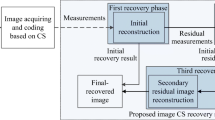Abstract
Greater compression ratio can be achieved while compressing images and videos by using the technique called compressive sensing or compressed sensing (CS). In CS, sparsity of the signal is exploited in order to achieve high compression. CS-based compression converts the images and video frames to a set of \(m<n\) measurements, which are transmitted to the receiver where the images and video frames are recovered by an efficient reconstruction algorithm with minimum error. Many reconstruction procedures solve least squares problem iteratively to recover the original signal, which ultimately increases the algorithmic complexity and runtime. In this work, split, process and merge technique for image and video reconstruction is proposed, which surpasses the adversities of the iterative algorithms, and provides better reconstruction performance in terms of perception and objective measures. Even with small number of measurements, the peak to signal noise ratio obtained using split and merge technique is above 30 dB, and the structural similarity is above 97% with an accuracy of 98% for both images and videos. The total runtime of the proposed algorithm is around 1.5 s and 9 s for images and videos respectively, which is small compared to iterative algorithms. Thus, the proposed split and merge technique based compressive sensing recovery algorithm proves to perform better in terms of speed and reconstruction quality.








Similar content being viewed by others
Availability of Data and Material
The data used in the work are the standard images (Lena, Onion, Peppers, Mother Daughter) and videos (Foreman series, Xylphone) that are available in MATLAB.
Code Availability
The software platform used is MATLAB 2016b. The algorithm was implemented in MATLAB scripts by the authors.
References
Dana, M. (2009). Compressed sensing makes every pixel count. What’s Happening in the Mathematical Sciences, 7, 114–127.
Shi, W., et al. (2019). Image compressed sensing using convolutional neural network. IEEE Transactions on Image Processing, 29, 375–388.
Izadi, V., Shahri, P. K., & Ahani, H. (2020). A compressed-sensing-based compressor for ECG. Biomedical Engineering Letters, 10, 299–307. https://doi.org/10.1007/s13534-020-00148-7.
Drori, I. (2008). Compressed video sensing. In BMVA symposium on 3D video—analysis, display, and applications.
Tony, C., & Lie, W. (2011). Orthogonal matching pursuit for the sparse signal recovery with noise. IEEE Transactions on Information Theory, 57, 4680–4688.
Zhi-xue, L., Gang, L., Hao, Z., & Xi-qin, W. (2012). Sparse-driven SAR imaging using MMV-StOMP. In Proceedings of 1st international workshop on compressed sensing applied to radar (CoSeRa).
Blumensath, T., & Davies, M. E. (2008). Iterative thresholding for sparse approximations. Journal of Fourier Analysis and Applications, 2008(14), 629–654.
Florence Gnana Poovathy, J., & Radha, S. (2015). Reduced runtime recovery algorithm for compressively sensed images. In Proceedings of 2nd international conference on next generation computing and communication technologies (ICNGCCT 2015), 22–23 April, Deira, Dubai (pp. 128–132).
Florence Gnana Poovathy, J., & Radha, S. (2015). Non-iterative threshold based recovery algorithm (NITRA) for compressively sensed images and videos. KSII Transactions on Internet and Information Systems, 9(10), 4160–4176.
Zhang, Z. Comparison of Sparse signal recovery algorithms with highly coherent dictionary matrices: The advantage of T-MSBL. Research note.
Mrak, M., Grgic, S., & Grgic, M. (2003). Picture quality measures in image compression systems. In EUROCON 2003. Computer as a Tool (Vol. 1, pp. 233–236). IEEE.
Kratochvil, T., & Simicek, P. (2005). Utilization of MATLAB for picture quality evaluation. Institute of Radio Electronics, Brno University of Technology, Czech Republic.
Hutter, F., Lin, Xu., Hoos, H. H., & Leyton-Brown, K. (2014). Algorithm runtime prediction: Methods and evaluation. Artificial Intelligence, 206, 79–111. https://doi.org/10.1016/j.artint.2013.10.003.
Croot, E., Granville, A., Pemantle, R., & Tetali, P. (2008). Running time predictions for factoring algorithms. In Algorithmic number theory, ANTS VIII, Banff, Springer LNCS (Vol. 5011, pp. 1–36).
Wickham, H. (2011). The split-apply-combine strategy for data analysis. Journal of Statistical Software, 40, 1–29.
Funding
This work was not funded by any agency.
Author information
Authors and Affiliations
Corresponding author
Ethics declarations
Conflict of interest
The authors have no conflicts of interest or competing interests.
Additional information
Publisher's Note
Springer Nature remains neutral with regard to jurisdictional claims in published maps and institutional affiliations.
Rights and permissions
About this article
Cite this article
Florence Gnana Poovathy, J., Sankararajan, R. Split–Process–Merge Technique-Based Algorithm for Accelerated Recovery of Compressively Sensed Images and Videos. Wireless Pers Commun 118, 93–108 (2021). https://doi.org/10.1007/s11277-020-08003-9
Accepted:
Published:
Issue Date:
DOI: https://doi.org/10.1007/s11277-020-08003-9




